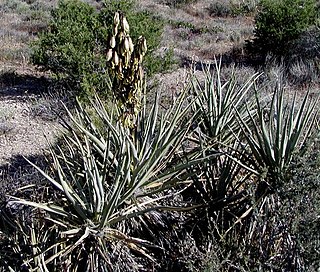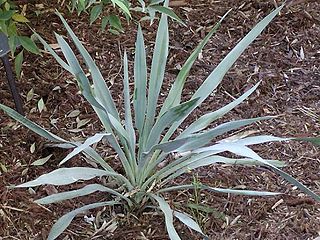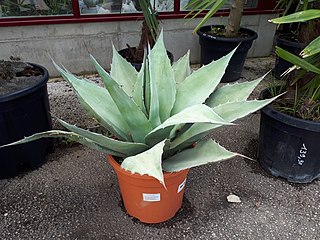
Yucca is a genus of perennial shrubs and trees in the family Asparagaceae, subfamily Agavoideae. Its 40–50 species are notable for their rosettes of evergreen, tough, sword-shaped leaves and large terminal panicles of white or whitish flowers. They are native to the Americas and the Caribbean in a wide range of habitats, from humid rainforest and wet subtropical ecosystems to the hot and dry (arid) deserts and savanna.

Yucca baccata is a common species of yucca native to the deserts of the southwestern United States and northwestern Mexico, from southeastern California north to Utah, east to western Texas and south to Sonora and Chihuahua. It is also reported in the wild in Colombia.

Yucca pallida, sometimes called pale yucca, is a species of yucca native to Northern Mexico and parts of the blackland prairies of northern and central Texas, and notable for its light-colored leaves that range from a pale blue-gray to sage-green in color.

Yucca schidigera, also known as the Mojave yucca or Spanish dagger, is a flowering plant native to the southwest deserts of North America.

Hesperoyucca whipplei, the chaparral yucca, our Lord's candle, Spanish bayonet, Quixote yucca or foothill yucca, is a species of flowering plant closely related to, and formerly usually included in, the genus Yucca. It is native to southwest communities of North America.

Agave attenuata, commonly called the foxtail or lion's tailagave or the swan's neck agave, is a species of flowering plant in the family Asparagaceae. Sometimes called the soft-leaf or soft-leaved agave, the aforementioned animal-related names are a nod to the appearance of the plant's inflorescence, which—after years, generally—rises slightly before gravity brings it back down, giving the bloom a curved, "swan"-like or "foxtail" look. The species' specific manner of flowering is unique in the genus Agave as most other species produce a towering, vertical display, reminiscent of a miniature tree.

Dasylirion wheeleri is a species of flowering plant in the asparagus family (Asparagaceae), native to arid environments of northern Mexico and the southwestern United States.

Yucca gloriosa var. tristis, known as curve-leaf yucca, curved-leaved Spanish-dagger or pendulous yucca, is a variety of Yucca gloriosa. It is often grown as an ornamental plant, and is native to the southeastern United States, from coastal southeastern Virginia south through Florida and west to Texas. In contrast to Y. gloriosa var. tristis, the leaves of Y. gloriosa var. gloriosa are hard stiff, erect and narrower.

Yucca rostrata also called beaked yucca, is a tree-like plant belonging to the genus Yucca. The species is native to Texas, and the Chihuahua and Coahuila regions of Mexico. This species of Yucca occurs in areas that are arid with little annual rainfall.

Thamnosma montana, the turpentine broom, or Mojave desert-rue, is a shrub in the citrus family Rutaceae. It is native to the deserts of the southwestern United States and northern Mexico. Except immediately after heavy rains, its straight stems usually lack leaves, giving it a broom-like appearance. The Latin specific epithet montana refers to mountains or coming from mountains.

Quercus grisea, commonly known as the gray oak, shin oak or scrub oak, is a North American species deciduous or evergreen shrub or medium-sized tree in the white oak group. It is native to the mountains of the southwestern United States and northern Mexico. It hybridises with four other oak species where the ranges overlap, the Arizona white oak (Q. arizonica), the Gambel oak (Q. gambelii), the Mohr oak (Q. mohriana) and the sandpaper oak (Q. pungens).

Yucca jaliscensis is a Yucca species native to the highlands of southwestern Mexico. Common names for this species include Jalisco Yucca, Jalisco Soapwort, Izote Yucca. It is native to mountainous areas at about 5000 feet in the States of Jalisco, Colima and Guanajuato.

Yucca angustissima, the narrowleaf yucca, is a plant in the family Agavaceae, known as the "narrow-leaved yucca." It is native to Arizona, New Mexico, Colorado and Utah, but grown elsewhere as an ornamental.

Yucca lacandonica is a plant species in the yucca genus with the common name "tropical yucca." It is native to Belize and to southern Mexico, the states of Chiapas, Veracruz, Tabasco, Quintana Roo, Campeche, and Yucatán. It is uniquely the only epiphytic species in the genus, although it has been reported to grow terrestrially as well.

Yucca baileyi is a plant in the family Agavaceae. It is native to Utah, Arizona, New Mexico and Colorado but has been cultivated elsewhere. Much of its native range is within the boundaries of the Navajo (Diné) Reservation, hence the common name "Navajo yucca." The Navajo people make extensive use of yucca fibers to make a wide assortment of useful and ceremonial items. They also use the roots as soap. It is not considered to be threatened, as it has a large range and an overall stable population.

Yucca thompsoniana, the Thompson's yucca, is a plant in the family Asparagaceae, native to Texas, Chihuahua and Coahuila. Other names for the plant include Beaked yucca, Soyate and Palmita.

Yucca utahensis is a species in the family Asparagaceae, native to Utah, Nevada and Arizona. McKelvey

Yucca aloifolia is the type species for the genus Yucca. Common names include aloe yucca, dagger plant, and Spanish bayonet. It grows in sandy soils, especially on sand dunes along the coast.

Hesperoyucca newberryi, commonly known as the Grand Canyon Quixote plant or Newberry's yucca, is a plant species endemic to Arizona. It is found only in Mohave and Coconino Counties, on the walls of canyons near the Colorado River.

Agave ovatifolia, the whale’s tongue agave, is a species of flowering plant in the family Asparagaceae. It is native to the Nuevo Leon region of the Chihuahuan Desert in northern Mexico.
























